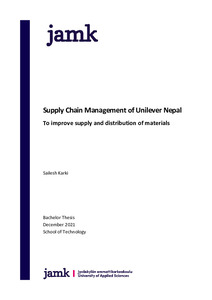Supply Chain Management of Unilever Nepal
Karki, Sailesh (2021)
Karki, Sailesh
2021
All rights reserved. This publication is copyrighted. You may download, display and print it for Your own personal use. Commercial use is prohibited.
Julkaisun pysyvä osoite on
https://urn.fi/URN:NBN:fi:amk-2021121325442
https://urn.fi/URN:NBN:fi:amk-2021121325442
Tiivistelmä
Nepal is achieving remarkable growth in Fast Moving Consumer Goods Industry in recent year because of rise in middle class population and higher demand of their different categories of products. Therefore, Unilever Nepal limited want to analyze its current supply chain process and improve the supply and distribution of finished goods to smoothen its supply chain management. The main purpose of thesis project is to analyze the current state of supply chain process of Unilever Nepal Limited and provide development suggestion based on the current process.
Data collection for the qualitative and quantitative research to formulate the whole thesis contains primary as well as secondary data. To study the research question, author had collected primary data through direct observation and interview with the supply chain manager of Unilever Nepal Limited. Throughout the internship period at Unilever Nepal Limited author has to study related theories and literature review through books, articles Journals and various internet sources to acquire secondary data and compare the real time scenario with the literature and extract the most feasible solution so as to develop the supply chain management.
The author has reviewed the supply chain process through literature and formulate a theoritical background for the reseach. Through current scenaio of supply chain process and the two different realtime business cases issues related to supply and distribution are identified through SWOT analysis and best possible suggestion is recommended to the company through the literature review.
In conclusion, the isuues related to supply and distribution can be overcomed with the execution of vendor managed inventory system which overcome demand uncertainity and then then supply of raw materials from supplier to factory warehouse needs to be improved for which company can expand its warehouse vertically through racking system and optimize its space utilization issue and manages it wahouse operation through warehouse management system. And that of the distribution of finished goods from factory to distribution centre can be improved by optimizing the truck loading technique through truck load managment system.
Data collection for the qualitative and quantitative research to formulate the whole thesis contains primary as well as secondary data. To study the research question, author had collected primary data through direct observation and interview with the supply chain manager of Unilever Nepal Limited. Throughout the internship period at Unilever Nepal Limited author has to study related theories and literature review through books, articles Journals and various internet sources to acquire secondary data and compare the real time scenario with the literature and extract the most feasible solution so as to develop the supply chain management.
The author has reviewed the supply chain process through literature and formulate a theoritical background for the reseach. Through current scenaio of supply chain process and the two different realtime business cases issues related to supply and distribution are identified through SWOT analysis and best possible suggestion is recommended to the company through the literature review.
In conclusion, the isuues related to supply and distribution can be overcomed with the execution of vendor managed inventory system which overcome demand uncertainity and then then supply of raw materials from supplier to factory warehouse needs to be improved for which company can expand its warehouse vertically through racking system and optimize its space utilization issue and manages it wahouse operation through warehouse management system. And that of the distribution of finished goods from factory to distribution centre can be improved by optimizing the truck loading technique through truck load managment system.
